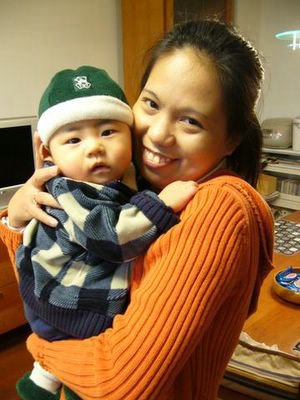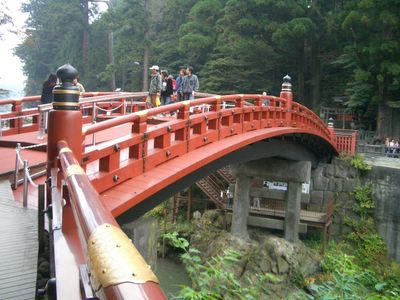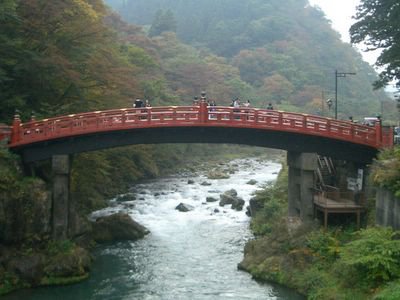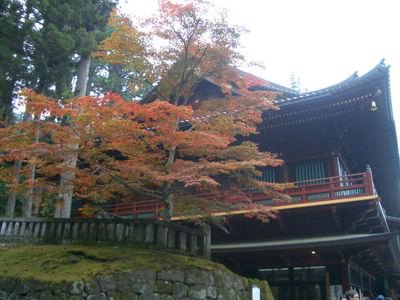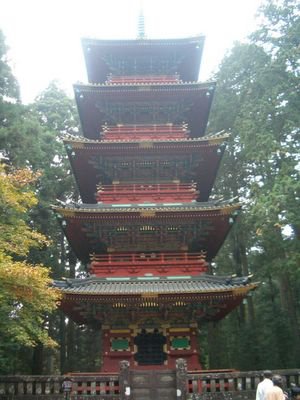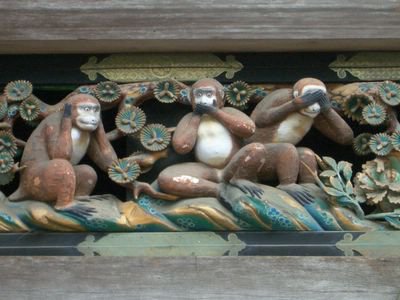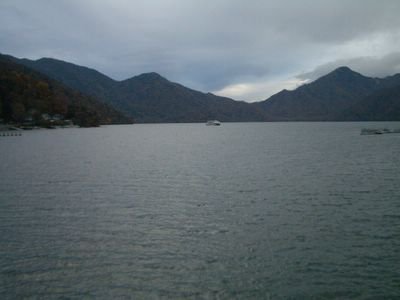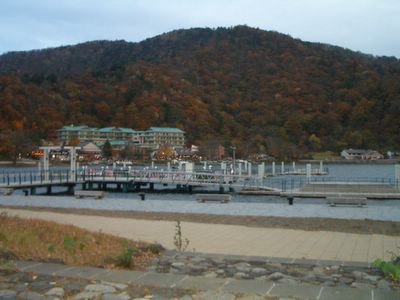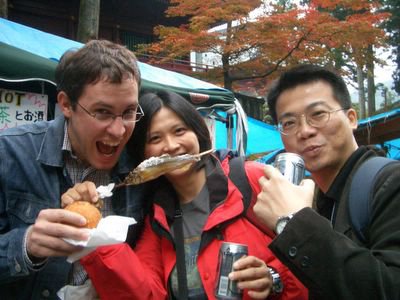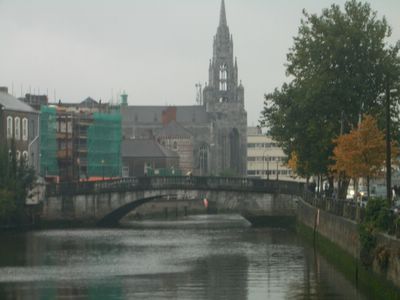Road Trips!
Friday, May 12, 2006
Boracay's Heat!
Saturday, May 06, 2006
Trying On A Japanese Umbrella
This was taken today, May 6 at the Nikko Edo Wonderland.
Friday, November 18, 2005
The Great Causeway
This is the great causeway. A magnificent work of art, sculptured by nature itself.
Miracles of nature.
The challenge
The toughest challenge I've faced so far. Cross a rope-bridge that's more than 500m high. I thought it was an easy feat because there was no wind and the weather seems to fully support my self-dare, but on our return, one of my buddies shook the rope bridge that I shrieked (as my friend puts it!).
Monday, November 14, 2005
Saturday, October 29, 2005
Nikko: A World Heritage
One of the shops, Hishi-ya (established 1868), makes exquisite yokan from a time-honored recipe, using only adzuki beans, sugar and seaweed gelatin. Only one pot is made every day, so each customer is limited to a single purchase.
The artisans who built Tosho-gu Shrine developed a local carving style known as Nikko-bori, characterized by detailed plant patterns and fine lacquer work. One shop, Mishima-ya, sells saucers, trays and other items made in the authentic Nikko-bori style. Thirty manufacturing steps are required to make each piece over a period of two or three years.
Nikko is also famous for its high-protein yuba, which is made by boiling soy milk and skimming off the thin top layer. It was originally served at Rinno-ji Temple as part of the shojin ryori (vegetarian) menu. Any visitor to Nikko should try yuba, with its nutty soybean flavor and most interesting texture.
This is the Shinkyo Bridge in Nikko. The Shinkyo (Sacred Bridge) is a beautiful red-lacquered bridge crossing the River Daiya at the entrance to the Nikko Mountain area. The bridge used to be known as Yamasuge-no-Jabashi (Bridge of Snakes with WIld Sedges), after a legend concerning the priest Shodo Shonin. It was constructed in its present form in 1636 and became known as Shinkyo because of its outstanding beauty. Except at special religious events, only the shogun and the Emperor or members of their retinue were allowed to cross it.
There are two Oyabashira (large pillars) at the center of the bridge and four at each bank. The head of each pillar is decorated with a knob called a giboshi in the shape of a leek. The handrails are beautifully decorated with golden metal fittings. The bridge is 27-m long, 6-m wide and 16-m above the surface of the water and is supported by stone pillars.
The Legend of Yamasuge-no-Jabashi Bridge. When Shodo When Shodo Shonin and ten of his disciples attempted to explore the Nikko mountain area in 767, they were halted by the River Daiya. The current was strong and there was no bridge by which to cross. Shodo Shonin began to pray fervently, and his prayers were answered by the god Jinja Daio, who appeared carrying a red and a blue snake. He threw these across the river, and they twined together, forming a bridge. The snakes had yamasuge (wild sedges) growing from their backs, enabling Shodo Shonin and his party to cross without slipping. When the bridge was built, it was called Yamasuge-no-Jabashi (Bridge of Snakes with Wild Sedges) in honor of Jinja-Daio.
***
A World Heritage. The Shrines and Temples Of Nikko.
Nikko has a long history that dates back hundreds of years ago. This place is a living testimonial to the old and withstanding Japanese civilization.
The Kaizando was constructed around 1720 as a token of reverence for the Buddhist priest Shodo, who is the founder of Rinno-ji and credited as the initiator of authentic religious activities in the Nikko Mountains. This vermilion-lacquered building decorated in Soben patterns shows typical elements of the China-influenced multi-storied architectural style of the middle Edo Period. Enshrining a statue of Bodhisattva Ksitigarbha as the custodian deity, it still is a living ritual site where a memorial service, called Kaisan-e, is celebrated on the first of April every year.
The Sanjunoto was erected in 1685 in the present location, where the Shihonryu-ji had been previously located, after its original structure constructed in 808 was lost in a fire in 1684. The smooth curved silhouette produced by pent roofs of gradually narrowing dimensions on the three-storied pagoda gives an impression of stability to the structure, at the same time offering a graceful presentation of the typical architectural style of the middle Edo Period. The Taiyu-in Reibyo Karamon, Yashamon and Kokamon, whose descriptions are given below separately, were erected in 1653 as a group of gates leading into the Taiyu-in Reibyo. They have been maintained to this day without any alteration in their form.
The Three Monkeys!
The monkeys were at first always associated with the blue-faced deity Vadjra, a fearsome god with three eyes and numerous hands. Their characteristic gestures of covering their ears, eyes and mouths with their paws were a dramatic pictorial way of conveying the command of the god.from "How Did It Begin: A fascinating study of the superstitions, customs, and strange habits that influence our daily lives” by R. Brash (Pocket Book, New York, 1969) which I found hereNormally it is rendered with the monkeys covering up their own eyes, ears etc but I wanted to do it so that they were all tangled together and censoring each other as well as self-censoring.
The Taiyu-in Reibyo Yashamon is a gate with four Chinese style gables, featuring eight supporting columns. Excellent workmanship is fully exercised in the structure and decorative design of the gate, especially in the peony carvings, which are applied consistently as the main motif for decorating this particular gate. Another example of excellent decoration is the pattern of decorative grooves carved on the columns. In addition, red and blue statues of Yaksa (a demonic deity) are enshrined as guardians in small enclosures at both sides of the front of the gate, while white and ultramarine statues of Yaksa are enshrined in enclosures at the back of the gate.
A closer look at the vast Chuzenji Lake. It feels so peaceful, so serene, so inviting. From the Tobu Nikko station, there are Tobu buses going all the way up here. The journey takes around 45 minutes at would cost around Y1100 one way.
Lake Chuzenji (Chuzenjiko) is a beautiful lake with forested shores in Nikko National Park, located at the foot of the sacred volcano Mount Nantai. The lake was formed by lava flows of the now extinct volcano several thousand years ago.
After members of the Imperial Family and aristocrats began building summer houses here, Nikko became a center for cross-cultural socializing during the hot summer months. Nikko Kanaya Hotel, which once catered to foreign guests, is legendary for its rainbow trout cuisine. This dish, flavored with soy sauce and mirin (sweet cooking sake), was popular at the time and is still available today. According to Mr. Karube of the hotel, visitors from abroad were very fond of this variety of Japanese cuisine.
Eventually, the summer population moved further and further away from the center of Nikko, in search of greater tranquillity and better views. As a result, the area around Lake Chuzenji became a popular resort and fishing spot. Europeans especially liked its resemblance to the Lake District of England, in terms of both climate and scenery. From Akechi-daira near the lake, the view encompasses the lake, Kegon Falls, and an awesome view of Mount Nantai. Kegon Falls, with its sheer drop of 99 meters, offers the most spectacular scenery in Nikko. Another enchanting spot, the Senjogahara wetlands north of the lake, has lovely alpine flowers.
Access to Lake Chuzenji and the inner regions of the national park is via the "Irohazaka Winding Road". The road ascends more than 400 meters in altitude and is named "Iroha", because the original road consisted of 48 needlepoint curves, the same number as there are letters in the Japanese syllabary, formerly known as "iroha". There are separate roads for uphill and downhill traffic.
Chuzenji Onsen, a touristy hot spring resort, is located at the top of the Irohazaka road, at the eastern end of the lake. The resort's most popular attraction is the Kegon-no-taki, a spectacular, 97 meter high waterfall. The base of the waterfall can be accessed via an elevator.
A nice panoramic view of the Kegon Falls and Lake Chuzenji can be enjoyed from the Akechidaira Plateau, which is accessible via a ropeway or on foot. To take the ropeway, get off at the Akechidaira bus stop, one stop before Chuzenji Onsen (served only by buses heading in direction of Chuzenji Onsen). At the resort's edge stands the second of the three Futarasan Shrines (the main shrine stands in central Nikko and the third on the summit of Mount Nantai). The trail to the summit of Mount Nantai starts from the shrine grounds. There is also a treasure house which displays some impressive swords.
A few hundred meters upstream from the confluence of Yukawa River into Lake Chuzenji, rumble the Ryuzu Falls, another set of spectacular waterfalls, particularly nice during the autumn leaf season, which usually reaches its peak in early to mid October.
(info taken from internet)
My 3 Nikko travelmates: Matthew who's all GREEN to munch Jingting's grilled fish (whom I suppose she'd be happy to oblige!) And Ken posing with a beer in his hands (I was the one who got to drink it though!). We eventually split up, these two (potential) love birds combed out the Nikko National Park area while Ken and I headed up north to enjoy late Chuzenji and plunge into an onsen.
Thursday, October 20, 2005
Discovering Northern Ireland
'When the world was moulded and fashioned out of formless chaos, this must have been the bit over - a remnant of chaos.' - Thackeray
Like the early people of North Antrim, Thackeray was very impressed by the strangeness of this place. Like other sophisticated visitors he had read that the Causeway is a geological freak, caused by volcanic eruptions, and cooling lava.
The ancients knew differently: clearly this was giants' work and, more particularly, the work of the giant Finn McCool, the Ulster warrior and commander of the king of Ireland's armies.
Finn could pick thorns out of his heels while running and was capable of amazing feats of strength. Once, during a fight with a Scottish giant, he scooped up a huge clod of earth and flung it at his fleeing rival. The clod fell into the sea and turned into the Isle of Man. The hole it left filled up with water and became Lough Neagh.
Finn was said to inhabit a draughty Antrim headland:
'He lived most happy and content, Obeyed no law and paid no rent.'
When he fell in love with a lady giant on Staffa, an island in the Hebrides, he built this wide commodious highway to bring her across to Ulster.
Before the famous coast road was built in the 1830s visitors complained about the ruggedness of the trip. But there was one shining compensation on the journey: the town where tourists made their last stop before the final push to the Causeway was Bushmills. Ever since 1608 saddle-sore travellers had been revived with magnums of the King's whiskey at the world's oldest (legal) distillery, which is still in business.
Monday, October 10, 2005
Day 2: Lost in Cork
Instead of taking the city tour, I've decided to have the taxi drop me off the first stop and then I set foot. Yup yup, equipt with nothing, not even a good map! I strolled and went through the narrow streets of Cork. I got lost. But I have found it all. Amazing isn't it? I was mistaken as reporting for work by the taxi driver, what do you know?! Hahaha, this means I don't pass for a tourist, which is great! I also met these fellow Pinoys who are so nice to me, they want to take me out. Hope I could really really fix my schedule for the weekend. Anyways, here's a photo stream of my
